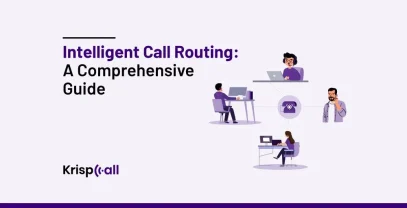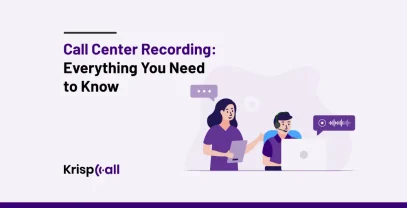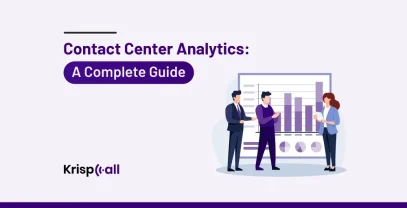Is your call center drowning in a sea of inbound calls? Do your agents spend their days answering repetitive questions, leaving them with little time to address complex issues? If so, it’s time to discover the power of call deflection.
Imagine a world where your call center is a haven of efficiency, where customers find solutions quickly and effortlessly, and your agents can focus on providing high-touch support. This is the transformative impact of call deflection.
In this blog post, we’ll delve into the world of call deflection, exploring the benefits of implementing this strategy and providing you with top strategies to boost customer experience.
What is a Call Deflection?
Call deflection is a technique of reducing the load of inbound calls by redirecting callers to different alternative communication channels. Often, the channels are self-service channels like community forums, informative articles, FAQs, or AI-powered chatbots and virtual assistants.
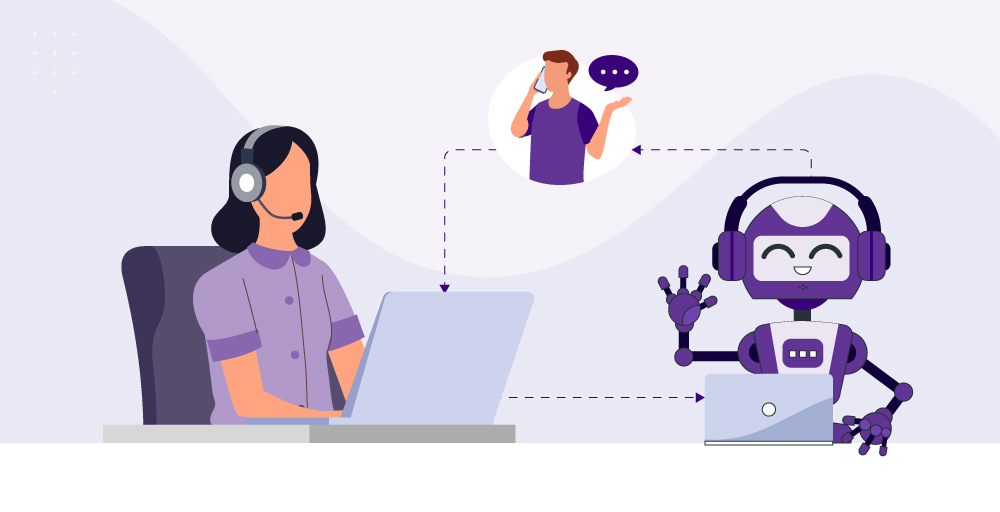
At first glance, call deflection may sound like a rude way to get rid of annoying customers. But in fact, it is quite the opposite.
Call deflections are designed to provide customers with a more efficient and flexible way to resolve their issues. Clients can choose the solutions that best fit their needs and preferences without the need to wait on hold, providing them with immediate and consistent answers.
How does call deflection work?
Call deflection works in a simple way. A customer calls a customer service representative (CSR) asking for help, and if the solution is simple and easily doable by the customer independently, the CSR asks the customer to join another channel where they can find the solution rather than explaining the fixes on call.
To keep it simple, imagine call deflection as a traffic system in a busy city, and incoming customer calls are the vehicles. Without the traffic system (call deflections), all the vehicles (customer calls) would converge onto a single and congested road (customer service representatives), causing delays and frustration.
However, with call deflection, it’s like having smart traffic signs that redirect certain vehicles to alternative routes, i.e., alternative channels in this case.
What is the difference between call forwarding and call deflection?
As both call forwarding and call deflection are strategies used to handle incoming calls, they are interchangeably used in the telecommunication industry. However, both mechanisms are entirely different.
Here’s a detailed comparison of Call Deflection vs Call Forwarding:
| Call Deflection | Call Forwarding |
| The call deflection mechanism redirects incoming calls to alternative communication channels. | The call-forwarding mechanism redirects incoming calls from one phone number to another. |
| Callers are well aware of the change in communication channels. | Callers can be unaware that their call is forwarded to another number. |
| Provides options to choose among channels like voice, emails, chat, and articles. | Takes away a customer’s control over their preferred channel, as it is limited to only voice channel |
| Utilizes automation and doesn’t solely rely on human agents. | Relies on human agents of other departments to handle calls. |
| Cost-efficient due to the application of existing digital channels. | Relatively expensive because of the need for multiple phone numbers and forwarding charges. |
| Facilitates sophisticated integrations with CRM systems and other business applications. | Operates independently and doesn’t offer the same level of integrations. |
What are the benefits of Call Deflection?
Call deflection reduces the volume of incoming calls, promoting the use of self-service options. Therefore, it is not only beneficial for a client or a customer but also for business owners and their employees.
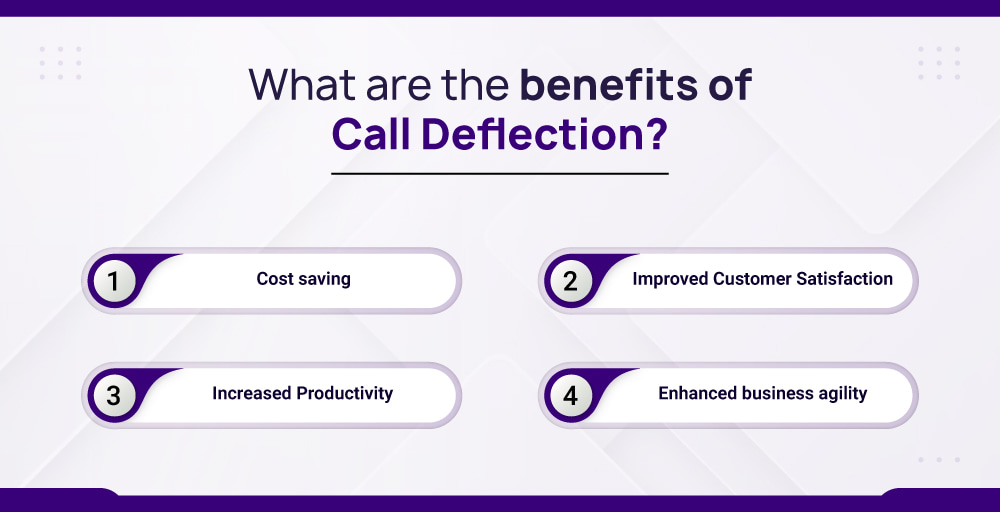
Here are some of the benefits of Call Deflection:
- Cost saving: Implementing reliable call deflection strategies reduces the need for a large number of support staff and infrastructures like phone lines, call centers, and other technologies, leading to substantial savings.
- Improved Customer Satisfaction: Call deflection provides customers the ability to choose their preferred channel, 24/7 availability & accessibility of services, and minimizes their wait times. This offers a more efficient and personalized customer experience, increasing customer satisfaction.
- Increased Productivity: As call deflection provides efficient allocation of resources and automation of routine tasks, call agents do not have to be stuck in one call to find out the customer’s preferred solution and can focus on other complex tasks. This increases the productivity of the overall business workforce.
- Enhanced business agility: Call deflection can help businesses adapt to changing customer needs and preferences, giving them more agility and scalability. For example, if a business is experiencing an increase in online sales, it can deflect calls to its website, mobile app, or other channels to handle the increased demand.
9 Best Call Deflection Strategies to enhance customer experience
Some of the best call-deflection strategies to enhance positive customer experience are as follows.
1. Implement IVR (Interactive Voice Response)
Interactive Voice Response (IVR) is a technology that facilitates the caller to interact with a computer system, guiding them through a menu of options using prerecorded voice prompts or dynamically generated audio.
Including IVR call deflection gives immediate access to frequently requested information and straightforward troubleshooting steps. This can handle a significant number of inbound calls, allowing customers to resolve their issues quickly and without waiting in phone queues.
However, it’s essential to design IVR systems with user-friendliness to avoid frustration and ensure a positive interaction for callers. To deal with the exact same thing, you can use KripsCall, a cloud-based VoIP system with numerous features, including a flexible and customizable IVR.
2. AI integration and automation
As the breakthroughs in AI (Artificial Intelligence) are shooting up, complex systems like NLP (Natural Language Processing) and CV (Computer Vision) are getting better day by day. Integrating and utilizing these techs with call deflection can provide the user with a human-like service with much more accuracy and time efficiency.
AI-powered chatbots and virtual assistants are useful in many cases as they can understand natural language and the intent of the customer’s inquiry and give responses accordingly.
This results in better call deflection rates by making interactions more conversational and intuitive.
3. Offer Call-backs
If a customer’s call was deflected, make sure to follow up with them after some time. This gives the customer a strong sense that you are truly being helpful and not just getting rid of their problems.
For callbacks, you can set up an entire team or just use automation to ask whether their problems are solved or not. If not, pair their call with a human agent of the related department to search for the solution.
4. Make your self-service engaging
Self-services like IVRs and knowledge bases are often boring and irritating, demotivating customers to use them. Therefore, business owners and team leads should focus on improving the user-friendliness of their self-services.
Interesting and engaging self-services could be achieved in a lot of ways like gamification of the services, including reward systems, and reducing complexity and confusion.
5. Establish a helpful Community
A helpful community of customers that provides valuable information, support, and solutions without being toxic and rude contributes to higher customer engagement and satisfaction. Imagine a platform where you can find answers quickly and collaborate with others, sharing each other’s experiences, insights, and solutions. It would be fun.
To successfully establish a supportive and helpful community, you can try various things, such as conducting welcome campaigns, setting up official moderators, promoting human-generated content, hosting Q&A webinars, and many more.
7. Use the Inquiry Ticket System
Providing tickets for customers and implementing ticket systems to handle inquiry calls can be very beneficial to large volumes of calls as well as to increase customer satisfaction.
A user-friendly ticket system with features like intelligent routing can help direct customer inquiries to the most appropriate customer support agents based on the nature of the issue. This resolves the issue faster, giving customers an overall great experience.
8. Optimize your Search Results
Deflected calls in digital channels like knowledge-base, FAQs, and forums with unoptimized search resulting tools can be a hassle for customers looking for solutions, especially those who are in a hurry. Therefore, optimizing your search results will ensure they find the exact information they are looking for.
Techniques like keyword optimization, using clear and detailed titles, improving meta tags, including cross-link-related articles, and many more are mostly used by industries in optimizing their search results. Also, keep the knowledge up-to-date and regularly update the contents.
9. Analyze Customer Behaviour
Keeping track of your customer’s behavior and responses gives you strong statistics suggesting the success of your call deflection and how well it is going. This helps you take calculated risks and choose the best-suited strategies to increase your call deflection rate.
To analyze customer behavior effectively, schedule regular surveys, keep track of the evaluation KPI (Key Performance Index) metrics, and utilize analytic tools. This helps you gather feedback and understand their needs more easily and efficiently.
How to measure the effectiveness of call-deflection strategies?
To measure whether the strategies you have been applying are effective or not, you can keep timely track of the following Key Performance Indicators (KPIs).
- Call Deflection Rate: This gives the percentage of successful call deflections, i.e., resolved customer inquiries without requiring the need for a live call agent. Increasing call deflection indicates that customers are resolving issues and finding answers on their own, reducing contact centers’ workloads.
- Customer Satisfaction Rate (CSAT): Conducting surveys and asking customers whether they are satisfied or not with the call deflection strategies and extracting the percentage rate of satisfied customers gives a meaningful insight of the effectiveness of the strategies.
- Cost Per Contact (CPC): Measuring the average cost per call with alternative channels and comparing it with calling over the phone makes it easier to check whether the call deflection techniques are suiting your company and generating some valuable gains.
Keep in mind that these are just general metrics, and keeping track of only a single metric could not measure the accurate effectiveness. So, make sure to use combined metrics that best fit your business style.
What are the challenges associated with Call Deflection?
While the benefits may make call deflection seem like a very viable go-to option, you should also consider the challenges it brings. Some of such challenges related to Call Defection have been listed and briefed below:
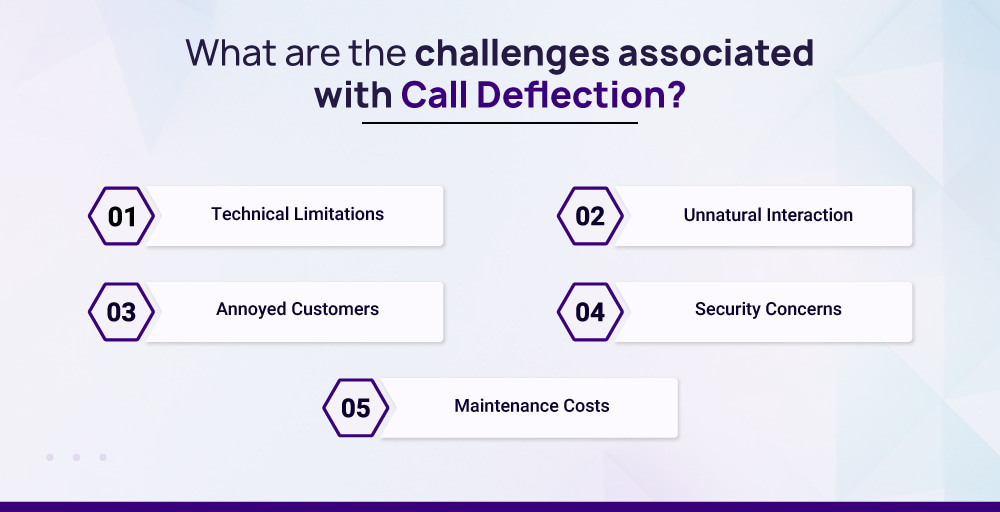
Technical Limitations
No matter how advanced chatbots or AI assistants are used for call deflection, such technologies may not solve some queries of people, let alone online resources.
If a person calls for a complex/ unique query, deflected calls may not be able to properly direct them. Or even if they do, who will guarantee if that is the right direction without being monitored by a human.
Unnatural Interaction
People generally tend to like to have personalized calls. And such technical limitations may also take away the natural notion of people talking on the calls. Talking to an actual human being may help them feel secure in many ways, especially if they are calling to seek some sort of solution.
But with deflected calls, people may have to go through unnatural interactions against their will.
Annoyed Customers
To be honest, the above points combined may sometimes leave people unsatisfied and annoyed.
You can also move your head around; if the calls are repetitive, not so helpful, and lack human-like feeling or emotion, why would you even want to be on call? The same goes for many people, they can easily get irritated and search for alternatives.
Security Concerns
The lack of human beings in charge of calls can also result in automated systems being exploited for their vulnerabilities. Such systems may end up losing classified or confidential information if not configured properly.
Also, security concerns may arise on the other end of the call if people are trying to resolve some technical issues. Misinterpretation of available information can cause a lot of harm in such scenarios.
Maintenance Costs
At a glance, the cost of arranging alternative communication channels may seem more economical than hiring loads of people, but that may not be the case for many. Hosting an AI assistant can cost a lot of money as well.
Moreover, the constant need to update the channels with the latest information may even hamper resource-level costs for a company.
Conclusion
To wrap this up, Call Deflection comes up as a very handy and cost-effective way to manage large-volume calls, utilizing digital channels and resources.
And, as the feather in its cap, the revolutionary breakthroughs in techs like AI and cloud computing make it even more promising in the telecommunication industry.
Therefore, if you, as an owner of a small enterprise or a large one, are planning to implement strategies to boost your customer experience using call deflection, don’t forget to check out KrispCall, as it offers numerous features in a cost-effective way.
With features like call data analytics, intelligent call routing, and IVR (Interactive Voice Response), KrispCall not only stands as one of the best solutions to improve your call deflection but also to revolutionize your overall telephony with its cloud-based system.
FAQs
What is call deflection rate and how to calculate it?
Call deflection rate is one of the metrics used to evaluate and measure how well and successful your call deflections have been over a certain period of time. In other words, it is a KPI (Key Performance Indicator) that gives the percentage of customer inquiries that are resolved through deflections without requiring assistance from a live agent.
Mathematically, the call deflection rate is calculated by:
Call Deflection Rate = Number of Resolved Inquiries by deflection/Total number of inquiries * 100
For instance, if a company gets 5,000 inquiry calls in a month from customers, and 1,000 of them are resolved by deflecting those calls to other channels. The deflection rate of the company over the period of that month is 1,0005,000100% i.e. 20%.
How to increase call deflection?
You can use different techniques to increase your call deflection; some of them are as follows:
- Implementing IVR (Interactive Voice Response) as your alternative deflection channel.
- Gamifying your self-services to make it more engaging.
- Optimizing your search results so that customers can find what they need
- Regularly updating your informative content and knowledge base.
- Utilizing AI (Artificial Intelligence) to create chatbots and virtual assistants.
What are the different call deflection channels?
Call deflections are not only limited to voice channels, they provide options for customers to choose among other preferred communication channels as well. Some of them are listed below:
- Chatbots
- Email Support
- Online Tutorials
- Virtual Assistants
- Online Knowledge Base
- IVR (Interactive Voice Response)
- Community Forums
- Social Media
- Discussion Groups



